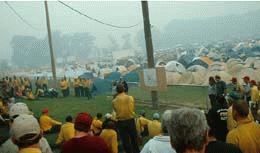Between August 5 and August 19, 2005, a wildfire burns nearly 52,000 acres of terrain in central Columbia and Garfield counties in the Blue Mountains. More than 100 homes and another 100 outbuildings are destroyed; costs to fight the fire eventually exceed $15 million. No deaths are reported, though at least one firefighter is injured seriously enough to be treated at an area hospital. The School Fire is the largest fire reported in the lower 48 states during the summer of 2005. The fire's origin is traced to a dead pine tree falling over power lines, causing the lines to arc and send sparks to the ground, which ignites dry grass.
Hot and Very Dry
Conditions were ripe for a major fire in the Blue Mountains during the first week of August 2005. A dry winter with below-average snowpacks had been followed by an unusually wet spring, resulting in a healthy crop of grass. The wet spring was superseded by a hot, dry summer, and by August fire danger had reached extreme levels only seen about once every 20 years.
On Friday, August 5, a dead pine tree fell over 14,000-volt power lines in School Canyon west of the Tucannon River in Columbia County, about 17 miles southwest of Pomeroy (in Garfield County). The power lines arced and sparks showered the ground, igniting the tall grass. Because the fire started in School Canyon, it was named the School Fire. The fire initially grew slowly, and by the following morning had burned only 300 acres. But then 20 m.p.h. westerly winds began to blow.
Blow Up
John Heckman, a fire behavior analyst and member of the type-one-incident command team that fought the fire, described what happened next as a "blow up" -- a rare event caused by dry conditions, plenty of dry grass, and high winds, which causes a fire to "compound exponentially" (Lewiston Tribune).
On Saturday afternoon, August 6, the fire jumped the Tucannon River and quickly expanded north and east, soon moving into Garfield County. Moving at between five and 10 miles per hour, the fire burned some 3,000 acres per hour that afternoon, consuming tall dry grass and occasional stands of trees. The trees shot burning embers hundreds of feet into the air, which the wind caught and deposited as much as half a mile away. The wind-borne embers created their own spot fires where they landed.
Experienced firefighters reported flames as high as 75 feet in the grass and up to 200 feet in trees. "That is tremendous fire behavior," said Heckman. "It's not common. The fire history in this area doesn't show that scale of an event" (Lewiston Tribune).
Fire Flying from the Trees
Smoke rose to 15,000 feet and was visible as far away as Spokane, 120 miles to the north. As the fire rapidly grew more serious on Saturday afternoon, a crew of sheriff's officers, Washington State Patrol officers, and Washington Department of Fish and Wildlife employees raced through a tangle of forest roads, cabins and camps in the fire's path, ordering everyone they saw to evacuate; residents were given from five to 30 minutes to grab their belongings and flee. Emily Ruchert, one of those ordered to evacuate from her property near Baker's Pond (Garfield County), said "We were worried, but we didn't think the fire would fly from the trees like it did" (Lewiston Tribune).
Clay Barr, Garfield County Emergency Director, said of the evacuation: "I can't believe someone wasn't seriously injured or killed. This ... land is tremendously complicated. I just can't believe they got everyone out" (Lewiston Tribune).
Steep and Deep Terrain
By August 7 nearly 600 firefighters were on the scene, but the fire continued to grow and by the evening of the 7th flames had consumed 32,000 acres. Firefighting efforts were impeded by the area's rugged terrain of steep mountain slopes with ravines and canyons, which not only had plenty of dry grass and timber to fuel the fire, but was also difficult for firefighters to access.
On August 8 the main path of the fire turned and began moving back to the south, wreaking further havoc. As more firefighters poured into the region, hundreds of tents sprang up to house them at the Garfield County Fairground in Pomeroy.
By August 9 more than 1,600 firefighters were fighting the fire. Their efforts that day were hampered by what Lori Hammer, a fire spokeswoman, described as "a lot of plume-dominated fire activity" (Lewiston Tribune). A Tribune article described plume activity as "when smoke billows high, builds and builds, and then collapses on itself. The (downward) rushing cloud sends fire-fanning winds down canyons and ridges."
By the evening of August 10 firefighters were gaining the upper hand, with the fire 40 percent contained; still, the fire burned an additional 7,500 acres before being declared 100 percent contained on August 19. Roads into the fire area were either closed or for restricted use only until October 8.
Total fire fighting costs exceeded $15 million. One hundred and nine cabins and 106 outbuildings were destroyed. The exact dollar amount of property damage was difficult to determine, though the Garfield County Assessor reported damage from the fire reduced its county tax rolls by more than a million dollars.

